
Battlefield attracts visitors to Gettysburg
GETTYSBURG, Pa.— As a student in high school, I had often seen the name Gettysburg printed in cold, black letters on the pages of lifeless history books that attempted to communicate the importance of one of the most significant Civil War battles.
After visiting the 6,000-acre battlefield located in the Gettysburg National Military Park, I have concluded that history books, although efficient in communicating facts, do not do Gettysburg justice.
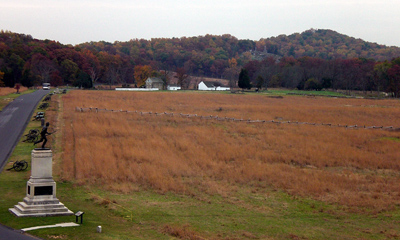 |
Gettysburg Battlefield is located on rolling Pennsylvania farmland covered with wooded areas (Photos by Michael Viera). |
The Gettysburg Battlefield assaults visitors with a sense of atmosphere and history almost immediately after they exit the confines of the Visitor Center. While the park’s Visitor Center offers family friendly ranger guided tours for $60, I opted to go on a self-guided auto tour of the massive site using the map provided by the park.
Katie Lawhon, Gettysburg’s public affairs specialist, recommended the auto tour since it allows visitors to get up close to monuments.
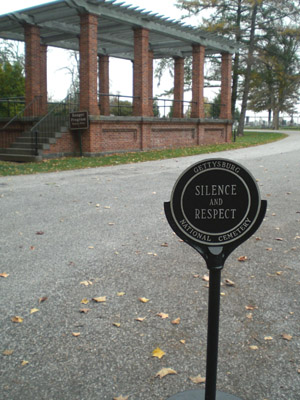 “There’s a lot to see in the battlefield,” Lawhon said by telephone prior to my visit. “It is one of the most important parks in America since there is so much history behind it.”
“There’s a lot to see in the battlefield,” Lawhon said by telephone prior to my visit. “It is one of the most important parks in America since there is so much history behind it.”
The history behind Gettysburg is commemorated through a series of statutes and monuments that comprise the 14-stop auto tour through the battlefield.
Beside each stop, convenient parking spots are provided for visitors to get a closer look at statues made in the likenesses of Confederate Gen. Robert E. Lee and Abraham Lincoln.
The order of the stops located on the map are meant to mimic the three-day trek that soldiers began on July 1, 1863, through the fields of Gettysburg that eventually culminated in a series of bloody battles.
Where many national parks are based around the idea of a place being a national treasure or a landmark, Gettysburg is different, not because it is commemorating a moment of joy in America’s history, but because it is honoring the deaths of thousands of soldiers.
Throughout the auto tour, it was evident even from a distance that many visitors were well aware that they were standing on land where thousands of soldiers had given up their lives.
Robert Kionis, a 25-year-old accountant, noticed the difference in the park from the moment that he arrived there.
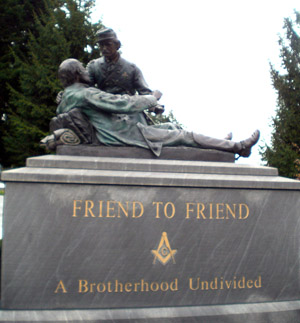 “I’ve been all over the U.S. to many different parks and things like that,” Kionis said. “But this place is a lot more emotional than any of the other parks that I have been to.”
“I’ve been all over the U.S. to many different parks and things like that,” Kionis said. “But this place is a lot more emotional than any of the other parks that I have been to.”
Throughout the entire field, the silence is deafening. Visitors stand motionless admiring the architectural beauty of the monuments and contemplate the significance behind them— a task that is daunting at best.
Perhaps the best time to soak in the entire battlefield is when arriving at the Pennsylvania Memorial, one of the final and most visually stunning stops on the auto tour. Amidst the backdrop of an overcast sky with only pockets of sunshine breaking through the clouds, the concrete gray monument is epic against the barren farmland.
Surrounding the monument are bronze plaques that list the names of soldiers who fought on the battlefield. The plaques not only list the names of those who fought and survived, but also of those who fought and died.
The monument does an excellent job of summarizing the significance of Gettysburg by allowing visitors to view a great majority of the field from its second floor, which can be accessed by climbing a flight of stairs.
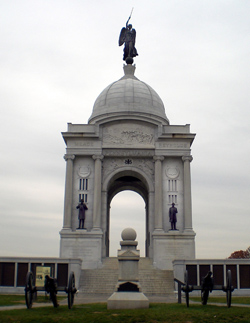 Once the end of the stairs is reached, Gettysburg can be appreciated for its quiet beauty and awe-inspiring scope.
Once the end of the stairs is reached, Gettysburg can be appreciated for its quiet beauty and awe-inspiring scope.
The field, although still mostly desolate and free from any modern day alterations, has suffered some minor changes that have become troubling for park rangers.
Paula Costantini, an information specialist at the park, admits that the field is not historically accurate as to what soldiers saw back in 1863.
“There are a lot more trees now than there were back then,” Costantini said. “Many times tour guides have to inform visitors that trees were not there when soldiers fought on sections of the battlefield, which is troubling.”
Despite the fact that time has affected the historical aspects of some sections of the Gettysburg field, history buffs still admire the national park. Costantini, who began working in the park in July 2005, has seen this appreciation first hand.
“I once had a kid step off the school bus and kiss the ground,” Costantini said. “He announced that he was happy to be on sacred ground.”
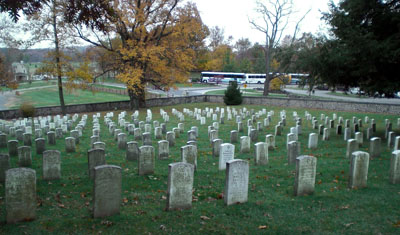 The ground of Gettysburg does not become more sacred than where the battlefield bleeds into the Gettysburg National Cemetery, where President Abraham Lincoln delivered his famous Gettysburg Address.
The ground of Gettysburg does not become more sacred than where the battlefield bleeds into the Gettysburg National Cemetery, where President Abraham Lincoln delivered his famous Gettysburg Address.
Where the battlefield is known for being open and easily accessible to the public, the cemetery is closed off, surrounded by imposing black gates that ward off any potential trespassers. Signs scattered throughout the cemetery announce silence and respect, which aid in communicating to visitors the importance and respect that the cemetery commands.
“There’s an eerie silence in the cemetery,” said Martha Gibson, who was there with her family on vacation. “It’s amazing that all these people died in order to make the country a better place.”
The cemetery at Gettysburg is an appropriate way to cap off the trip to the national park. While looking down a hill filled with white headstones marking the deaths of thousands of soldiers, the 40-mile wide park suddenly does not seem that large anymore.
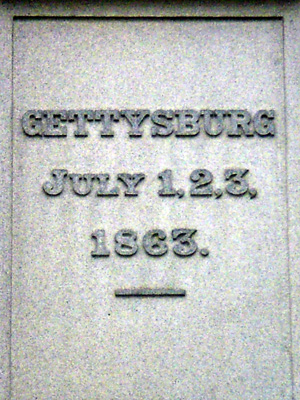
If You Go
- Dress according to the season. Summers in Gettysburg are warm while the Fall and Winter seasons fluctuate from mild to cold.
- Bring an umbrella. Being a large open space, the park contains virtually no place to seek shelter in the event of a rainstorm.
- Prepare to pay moderate to expensive prices for tours. A bus tour ticket for adults is $23.25 while children’s tickets go for $12. Private ranger guided tours can be as much as $145, according to the size of the party.
- Bicycles are allowed on the battlefield trails, which makes it easy to travel from site to site.
- Parking on site is free of charge.

Comments are Closed